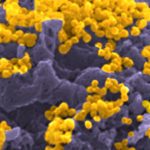Link to Pubmed [PMID] – 28630473
Sci Rep 2017 Jun;7(1):3767
The density and distribution pattern of epitopes at the surface of pathogens have a profound impact on immune responses. Although multiple lines of evidence highlight the significance of antigen surface density for antibody binding, a quantitative description of its effect on recognition mechanisms is missing. Here, we analyzed binding kinetics and thermodynamics of six HIV-1 neutralizing antibodies as a function of the surface density of envelope glycoprotein gp120. Antibodies that recognize gp120 with low to moderate binding affinity displayed the most pronounced sensitivity to variation in antigen density, with qualitative and substantial quantitative changes in the energetics of the binding process as revealed by non-equilibrium and equilibrium thermodynamic analyses. In contrast, the recognition of gp120 by the antibodies with the highest affinity was considerably less influenced by variations in antigen density. These data suggest that a lower affinity of antibodies permits higher dynamics during the antigen recognition process, which may have considerable functional repercussions. These findings contribute to a better understanding of the mechanisms of antigen recognition by antibodies. They are also of importance for apprehending the impact of antigen topology on immune-defense functions of antibodies.

